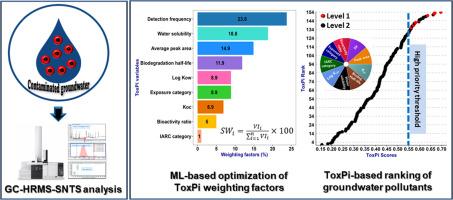Prioritization of monitoring compounds from SNTS identified organic micropollutants in contaminated groundwater using a machine learning optimized ToxPi model
IF 11.4
1区 环境科学与生态学
Q1 ENGINEERING, ENVIRONMENTAL
引用次数: 0
Abstract
Advanced suspect and non-target screening (SNTS) approach can identify a large number of potential hazardous micropollutants in groundwater, underscoring the need for pinpointing priority pollutants among detected chemicals. This present study therefore demonstrates a novel multi-criteria decision making (MCDM) framework utilizing machine learning (ML) algorithms coupled with toxicological prioritization index tool (i.e., ml_ToxPi) to rank 252 chemicals of interest in groundwater for subsequent targeted analysis. The MCDM framework integrated chemical analysis data (i.e., peak area and detection frequency), toxicity profiles (i.e., bioactivity ratio, human exposure metadata, and carcinogenicity metadata), as well as the environmental fate and transport information (i.e., octanol-water partition coefficient (log Kow), water solubility, biodegradation half-life, and soil adsorption coefficient (Koc)) for ranking the identified pollutants, and the random forest machine learning model was useful for systematically determining the weighting factors of each variable according to their variable importance scores (R2 = 0.808 and 0.778 for training and testing datasets, respectively, while RMSE = 0.042 in both cases). A total of 47 unique high priority compounds (i.e., ml_ToxPi score ≥ 0.55) were identified across the investigated sampling regions, which constituted diverse groups of compounds classified according to their chemical uses, such as alkylated polycyclic aromatic hydrocarbons (alkyl-PAHs), organophosphate flame retardants (OPFRs), parent PAHs, personal care products (PCPs), pesticides, pharmaceuticals, phenols, plasticizers, transformation product (TPs), and other industrial use chemicals. By incorporating relevant variables into the proposed ML-optimized ToxPi MCDM framework, the prioritization approach described here may be adopted in future SNTS assessment of environmental and biological media.


利用机器学习优化的 ToxPi 模型,从 SNTS 确定的受污染地下水有机微污染物中确定监测化合物的优先次序
先进的疑似和非目标筛选(SNTS)方法可以识别出地下水中大量潜在的有害微污染物,这凸显了在检测到的化学品中确定优先污染物的必要性。因此,本研究展示了一个新颖的多标准决策(MCDM)框架,利用机器学习(ML)算法和毒理学优先排序指数工具(即 ml_ToxPi)对地下水中 251 种相关化学品进行排序,以便随后进行有针对性的分析。MCDM 框架整合了化学分析数据(即峰面积和检测频率)、毒性概况(即生物活性比、人体暴露元数据和致癌性元数据)以及环境归宿和迁移信息(即、随机森林机器学习模型可根据各变量的重要性得分,系统地确定各变量的权重系数(训练数据集和测试数据集的 R2 分别为 0.808 和 0.778,RMSE 均为 0.042)。在所调查的采样区域中,共鉴定出 47 种独特的高优先级化合物(即 ml_ToxPi 分数≥ 0.55),这些化合物根据其化学用途构成了不同的化合物群,如烷基多环芳烃(alkyl-PAHs)、有机磷阻燃剂(OPFRs)、母多环芳烃(PAHs)、个人护理产品(PCPs)、杀虫剂、药品、酚类、增塑剂、转化产物(TPs)和其他工业用化学品。通过将相关变量纳入拟议的 ML 优化 ToxPi MCDM 框架,本文所述的优先级排序方法可在未来的环境和生物介质 SNTS 评估中采用。
本文章由计算机程序翻译,如有差异,请以英文原文为准。
求助全文
约1分钟内获得全文
求助全文
来源期刊

Water Research
环境科学-工程:环境
CiteScore
20.80
自引率
9.40%
发文量
1307
审稿时长
38 days
期刊介绍:
Water Research, along with its open access companion journal Water Research X, serves as a platform for publishing original research papers covering various aspects of the science and technology related to the anthropogenic water cycle, water quality, and its management worldwide. The audience targeted by the journal comprises biologists, chemical engineers, chemists, civil engineers, environmental engineers, limnologists, and microbiologists. The scope of the journal include:
•Treatment processes for water and wastewaters (municipal, agricultural, industrial, and on-site treatment), including resource recovery and residuals management;
•Urban hydrology including sewer systems, stormwater management, and green infrastructure;
•Drinking water treatment and distribution;
•Potable and non-potable water reuse;
•Sanitation, public health, and risk assessment;
•Anaerobic digestion, solid and hazardous waste management, including source characterization and the effects and control of leachates and gaseous emissions;
•Contaminants (chemical, microbial, anthropogenic particles such as nanoparticles or microplastics) and related water quality sensing, monitoring, fate, and assessment;
•Anthropogenic impacts on inland, tidal, coastal and urban waters, focusing on surface and ground waters, and point and non-point sources of pollution;
•Environmental restoration, linked to surface water, groundwater and groundwater remediation;
•Analysis of the interfaces between sediments and water, and between water and atmosphere, focusing specifically on anthropogenic impacts;
•Mathematical modelling, systems analysis, machine learning, and beneficial use of big data related to the anthropogenic water cycle;
•Socio-economic, policy, and regulations studies.
 求助内容:
求助内容: 应助结果提醒方式:
应助结果提醒方式:


